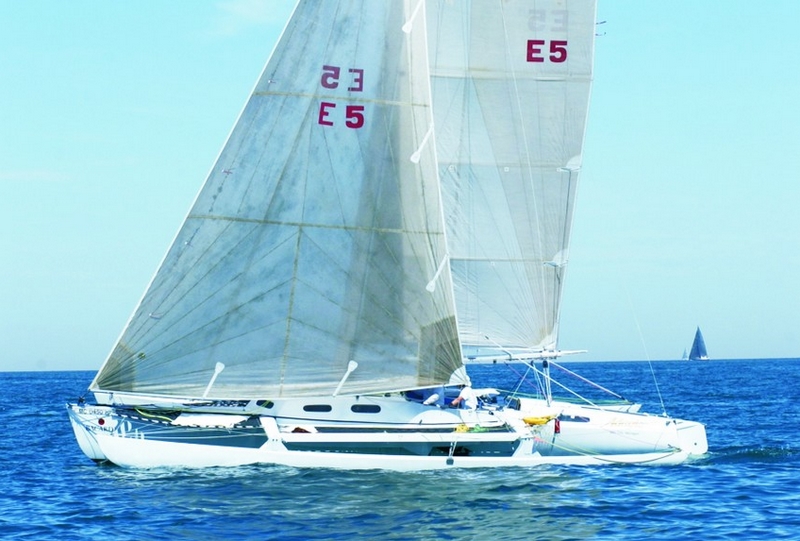
In the Chicago to Mackinac Race
By Meade Gougeon — GBI Founder
Above: Adagio, Meade Gougeon’s 35′ trimaran in the Chicago to Mackinac Race. This boat is a testament to how many decades wood epoxy structures can last.
The 35′ trimaran Adagio, designed and built by Meade and Jan Gougeon in 1969, survived the harrowing conditions at the finish of the 2002 Chicago to Mackinac race this past year.
The old lady
Adagio, the first large wood/epoxy structure ever built without the use of fasteners, was one of the oldest, and lightest boats in the race. She has now become a testbed as to how long wood/epoxy structures can last. Over the years, the Gougeon Brothers’ test lab has developed an extensive wood fatigue database that has been of great help to designers and engineers. But Adagio is unique in that she was built to the edge at 2300 lb and has seen a great many fatigue load cycles in her 32 years, making her a real-time test machine on how well wood/epoxy technology can perform in difficult fatigue environments.
The blast
The Chicago to Mackinac Race began as a typical downwind slide with the wind building up to 25 knots out of the south and continuing over the next 24 hours. This permitted Roy Disney’s California-based Pyewacket, the largest boat in the race, to set a new course record. Close behind her were 12 Great Lakes 70 Class sleds with Adagio the lead multihull ranging back and forth in the middle of this fast company from 3rd to 8th. Things got interesting towards the end of the race as the wind continued to drop and finally quit, leaving the GL-70 fleet and Adagio all grouped together in a tight circle under the Mackinac Bridge.
On one of the oldest, lightest boats in the Chicago to Mackinac race… we were doing everything possible on Adagio to slow down and maintain control.—Meade Gougeon
Within 45 minutes Adagio caught a faint breeze and was first to break out of the pack and head to the finish line only 5 miles away. The long-term quest of beating all the GL-70 class boats was within her reach. But enthusiasm for the race clouded our judgment. Forming directly behind us was the biggest, baddest storm that has been seen in this area in some years. Good seamanship should have dictated that all sails be struck to ride bare pole to the finish and be damned with the race. When the first big gust hit, we knew we were in over our heads. We were able to roll in our jibs, but the big 425 sq ft mainsail was immovably plastered against the sidestays, and all we could do was hang on and ride it out as best we could.
Meanwhile, the GL-70 class boats had hoisted spinnakers and were screeching downwind at 25-30 knots, some taking spectacular wipeouts, as we were doing everything possible on Adagio to slow down and maintain control. We don’t know the top speed we hit during this maelstrom, but it was certainly over 30 knots and the fastest that Adagio has ever gone. Winds of 69 mph were recorded at the Mackinac Bridge and the Coast Guard recorded a gust in the high 70’s.
Adagio missed finishing ahead of the GL-70 fleet by 2 seconds, behind Holua, a Santa Cruz 70, who remarkably carried her full spinnaker almost to the finish without mishap. Even though we were the third boat to finish in this prestigious race, we were mainly just happy to finish in one piece and be able to race another day.
The storm took a heavy toll, and there were many boats in the Chicago to Mackinac Race that were not so lucky as ourselves, who suffered torn sails, gear breakage, and dismasting. One 43′ trimaran was capsized.
A week earlier, Adagio had won the Open Class in the Bayview (Port Huron) to Mackinac race, which she has won twice before. This together with two previous wins in the Chicago race has elevated Adagio to a super boat status by the rating committee, making her the highest-rated 35′ boat on the planet with a PHRF rating of -63, roughly equal to that of a 70′ high-performance monohull.
Adagio is competently sailed by long-term crew J.R. Watson, Butch Babcock, Jan, and Meade Gougeon. The average age of this hot dog crew is 60.5 years.





